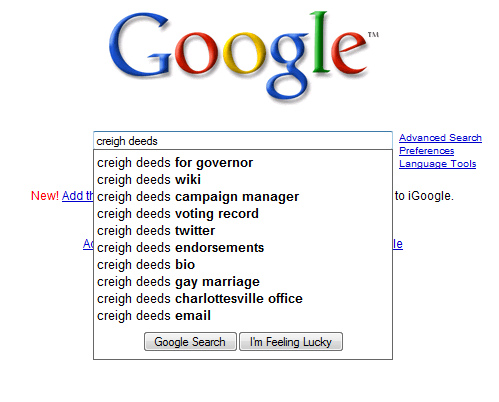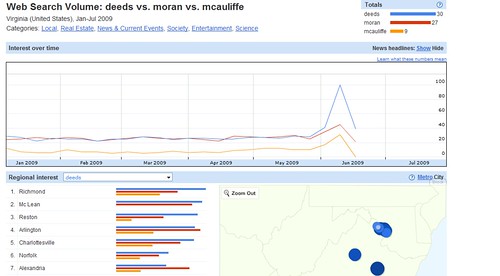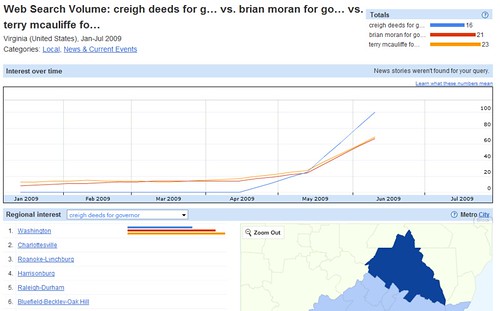Much has been written about Creigh Deeds’ use of the Google network blast (also known as the Google surge or Google blast) in Northern Virginia at the tail end of that state’s Democratic Gubernatorial primary race. Whilesome have suggested that his use of this tactic may have carried him to victory, I am not quite sold by that line of thinking and decided to take a closer look myself.
For the uninitiated, the Google surge occurs when a campaign, be it a candidate or an organization, saturates a geographic area with their ads days leading up to a vote through the Google Ad Network. Representatives of Google are usually involved in setting up the such ad buys. I first heard of its use in California during the Prop 8 battle. The group in favor of prop 8 spent close to $500,000 in online ads in the 48hrs leading up to the November 4th election through Google’s content network. The group’s ads were targeted to all residents of California (including Google HQ even though Google opposed prop 8). Several months later, Scott Murphy (D) used the same tactic in the NY-20 Special election where he was facing Jim Tedisco (R). Kate Kaye reported that the Murphy campaign spent around $25,000 in the 36 hours prior to election day to target the entire NY-20 district. Though it’s largely agreed upon in the online politics world that these campaigns demonstrated a successful use of the Google surge, I’ve yet to see the data to back up this consensus.
As I see it, the benefits to using the Google Surge near the end of campaign are as follows:
- Increased traffic to the campaign’s website
- Increased number of Google search of the candidate or campaign issue
- Increased visibility to and impression on voters.
The third benefit is the most subjective and the hardest to measure. It’s true that ad providers can provide reports of the number of times an ad has been viewed along with the click thru rate. However, it’s still rather difficult to measure the impact of the creative on voters that viewed the ad without taking further action. At such a late stage of the game, most campaigns are likely to run persuasive ads that would appeal to undecided voters. That being said,the fact remains that after the polls close, a campaign has no recourse to prove or measure that previously undecided voters had casted a ballot for their candidate or stance on an issue.
The first benefit is more quantifiable and measurable. However, since I was not a part of the any of the campaigns that have used Google Surge thus far, that data is not available to me. Thus I can not venture to guess as to effectiveness of the Google blast based on that. I do invite any with access to data to write a guest post on this blog.
Lastly, the second benefit is one we can explore further using Google Insights. In theory, if the Google blast was an effective tactic, there should be a surge in the number of times a candidate’s name has been Googled. Going back to VA’s gubernatorial race, we should see a spike in the number of Google searches for Creigh Deeds since his campaign used Google blast. I started by using Google suggest to determine what other terms people were using along with its name when searching.

I arbitrarily settled on the following three search combinations:
- The candidates’ last name: “Deeds” vs “Moran” vs “McAuliffe”
- The candidates’ full name: “Creigh Deeds” vs “ Brian Moran” vs “Terry McAuliffe”
- The candidates’ full name in addition to the words “for governor”:“Creigh Deeds for governor” vs “Brian Moran for governor” vs “Terry McAuliffe for governor”
Let’s take a look at the numbers:
1. “Deeds” vs “Moran” vs “McAuliffe”
2. “Creigh Deeds” vs “Brian Moran” vs “ Terry McAuliffe”
3. “Creigh Deeds for governor” vs “Brian Moran for governor” vs “Terry McAuliffe for governor”
Across all three search comparisons, we see a surge of search volume for Deeds as we get closer to the election. However, the climb in volume begins well before the Google blast went into affect. Looking at these graphs, it appears that the Google Blast that started on the eve of the election was part of a much more sophisticated and integrated online plan that increased Creigh Deeds’ visibility at the right time during the campaign cycle. An analysis of the Virginia primary map supports the idea that there was more to Deeds’ victory beside the Google blast given that systematically beat his opponents throughout the state. Where does that leave the Google Blast? Good tool or not? The truth is that I don’t know. The look at the insights numbers is a very unscientific analysis of only one of the three ways the Google blast can benefit a campaign. A look at the other two would provide a more complete picture as to the effectiveness of the tool. While the survey is still out on Google blast, I believe that having and then executing an online plan that effectively tells the complete story of your candidate throughout the campaign will be much more effective then any last minute surge.





